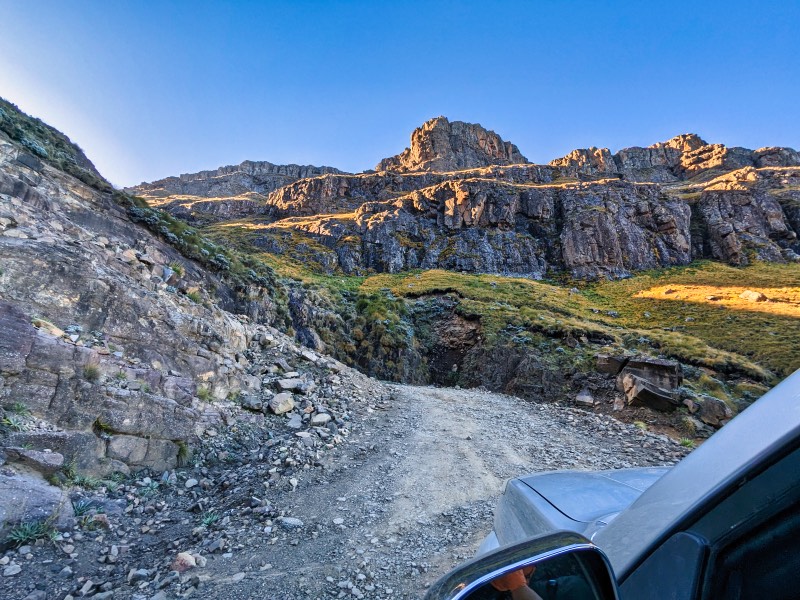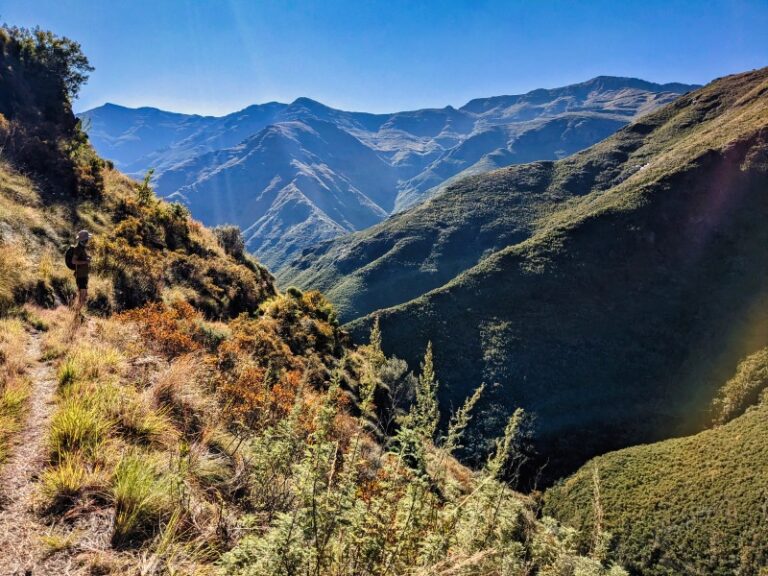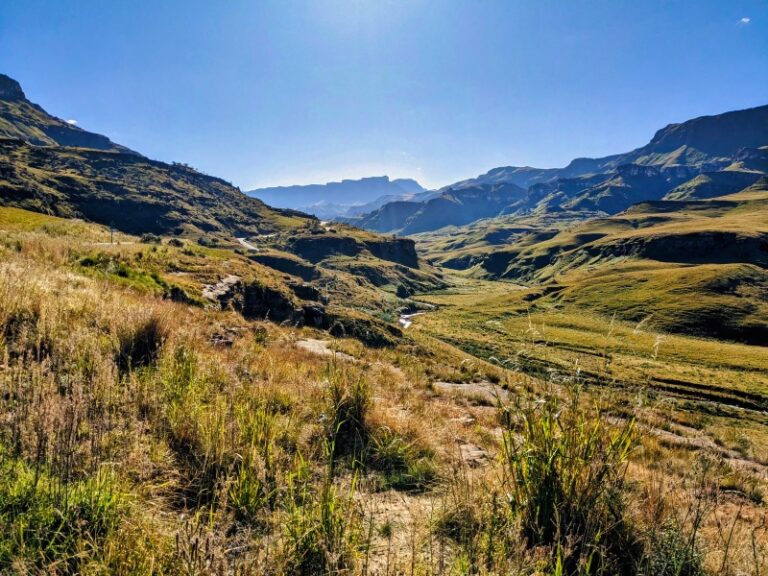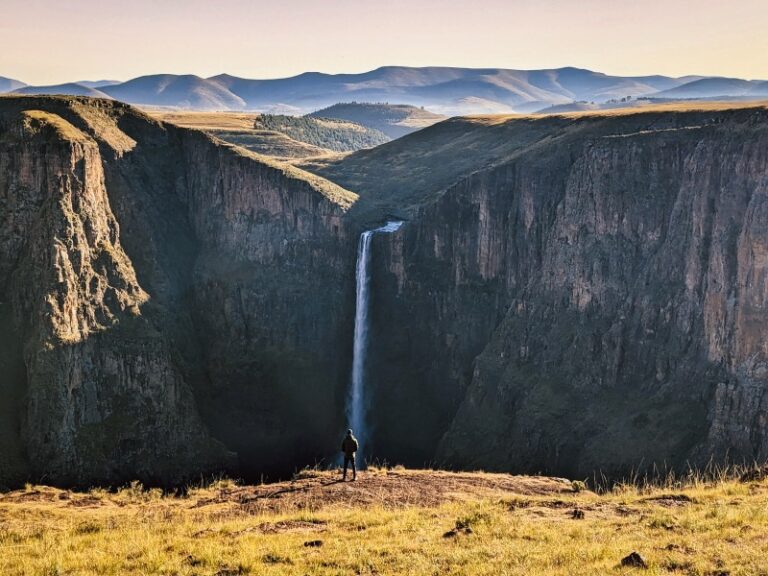How to Conquer Sani Pass (+ The Best Sani Pass Tours)
If you’re travelling through Southern Africa and want an epic mountain drive, look no further than the Sani Pass connecting South Africa and Lesotho. Combining stunning mountain scenery and just the right amount of challenge, this thrilling scenic route is bound to get your heart pumping and your eyes popping. Not only that, you can reward yourself at the end with a drink at one of the highest pubs in Africa.
The Sani Pass really is an amazing drive and better than we expected. It’s not just a way to get to Lesotho, it’s an attraction in itself.
Interested in conquering the Sani Pass yourself, whether by driving or taking a Sani Pass tour? Read on for our complete guide to the Sani Pass featuring all the information you need to know including the best Sani Pass tours.
Lesotho Travel Resources
- Getting there: search for flights to Lesotho
- Where to stay: search for hostels and hotels
- Rent a car: search for deals on car rentals
- Get around: hire a top-rated driver to get around Lesotho
- Travel insurance: get travel insurance for your trip
- Money: get a Wise travel card to save big-time
- Tours: check out the best Lesotho tours
What is the Sani Pass?

The Sani Pass is a high-altitude mountain pass road located in the Drakensberg Mountains, connecting the countries of South Africa and Lesotho.
The road is known for its challenging and steep terrain (think lots of big rocks and around 13 tight switchbacks!), making it one of the most iconic mountain passes in Southern Africa.
The pass climbs over 1300m to level out at an elevation of about 2876m. At times, the gradient rises on a 1:3 ratio. If you’ve ever done any hiking, you’ll know how steep that is.
Looking to explore more of Lesotho? Check out 15 Awesome Things to Do in Lesotho
Where is the Sani Pass
- Region: KwaZulu-Natal, South Africa
- Starting Point: Himeville, South Africa (1544m)
- Ending Point: Mokhotlong, Lesotho (2876m)
The Sani Pass is located in the Drakensberg Mountains between South Africa and Lesotho. The pass connects the town of Himeville in the KwaZulu-Natal province of South Africa with the town of Mokhotlong in Lesotho.
Getting to the Sani Pass

Since you’ll be approaching the Sani Pass from the South African side, you can get there from either Durban or Johannesburg.
Getting to the Sani Pass from Durban
The drive from Durban to Himeville (the start of the Sani Pass) takes 3 to 4 hours. You can reach Himeville by taking the N3 towards Johannesburg to the R617 towards Underburg Howick.
Getting to the Sani Pass from Johannesburg
The drive from Johannesburg takes 7 to 8 hours. You can reach Himeville by taking the N3 towards Durban and then the R617 towards Underburg Howick.
If you’re coming from Joburg, be sure to stop by Golden Gate National Park on the way. It’s so beautiful!
Read: 15 Awesome Things to Do in Johannesburg
Best Time to Drive the Sani Pass
If you’re driving the Sani Pass yourself, the best time to drive the Sani Pass is during the drier months, which typically occur in late autumn. Specifically, the months of March through early June are considered the most favourable for travelling the pass. During this period, you are more likely to encounter better road conditions, milder temperatures, and less precipitation.
Winter (May to August) can bring colder temperatures and occasional snowfall to the Sani Pass, making the road more challenging and potentially hazardous. It’s not recommended to attempt the pass during winter unless you have experience driving in snowy and icy conditions.
Related: How to Visit Maletsunyane Falls and Semonkong
Before planning your trip, be sure to check local weather conditions and road reports, as conditions can change, and the pass may be temporarily closed due to weather or maintenance. Additionally, keep in mind that the Sani Pass is a high-altitude route, so even in the warmer months, temperatures are cooler.
If you’re embarking on a Sani Pass tour, then this won’t apply as much, as your driver will be very experienced in all conditions! You’ll still want to pack a warm jacket though.
What is the Sani Pass road like?
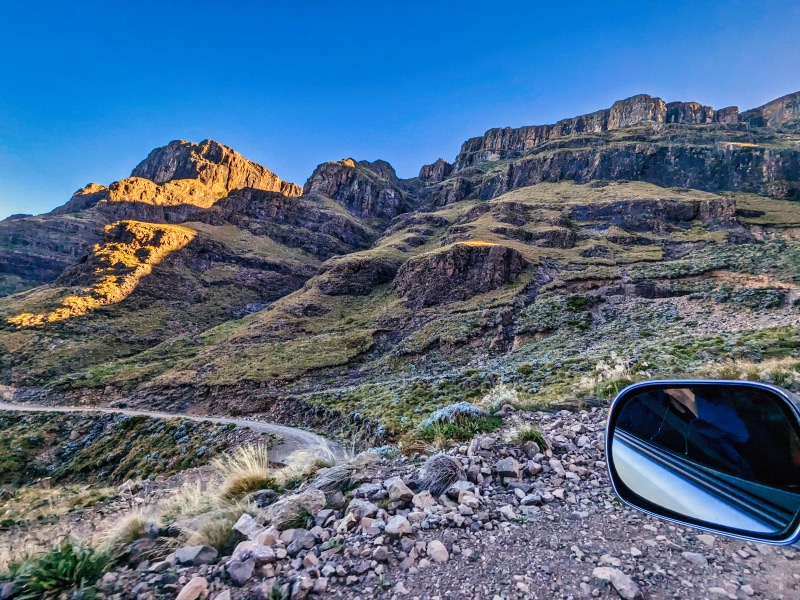
The Sani Pass is a road like no other. We loved our Sani Pass adventure!
As for conditions, the road is paved until the South Africa border control station and then paved again after the Lesotho border control.
This leaves the section between the border posts: a dirt road ranging from rough to very rough – but that’s where all the fun is! On this section, there is a series of hairpin turns and parts of the road can be washed out and rocky at times. As the road climbs over 1300m, there is also no shortage of steep sections, especially on the last few turns.
As you would expect, the road is extremely scenic. The journey starts by going through the stunning Giant’s Castle area of the Drakensberg and continues up the sweeping escarpment. There are multiple spots to stop and take in the view (and a few photos too) along the way.
How to Visit the Sani Pass
There are two main ways for travellers to reach the Sani Pass: self-drive and guided tours.
Driving the Sani Pass
For (semi) experienced 4×4 drivers (and above) with access to a reliable vehicle, this is the best option.
Self-driving the Sani Pass allows you the freedom and space to head up there on your own schedule and to travel on your own terms.
We self-drove the Sani Pass after we bought our car in South Africa and we really loved it!
If you don’t have your own set of wheels, you can rent a car easily in South Africa for the journey – trust us, Lesotho is best done by road trip.
Pro tip: use Discover Cars to find the best deals on rentals for your Sani Pass adventure. It’s what we personally use and recommend.
How Difficult Is Driving the Sani Pass?
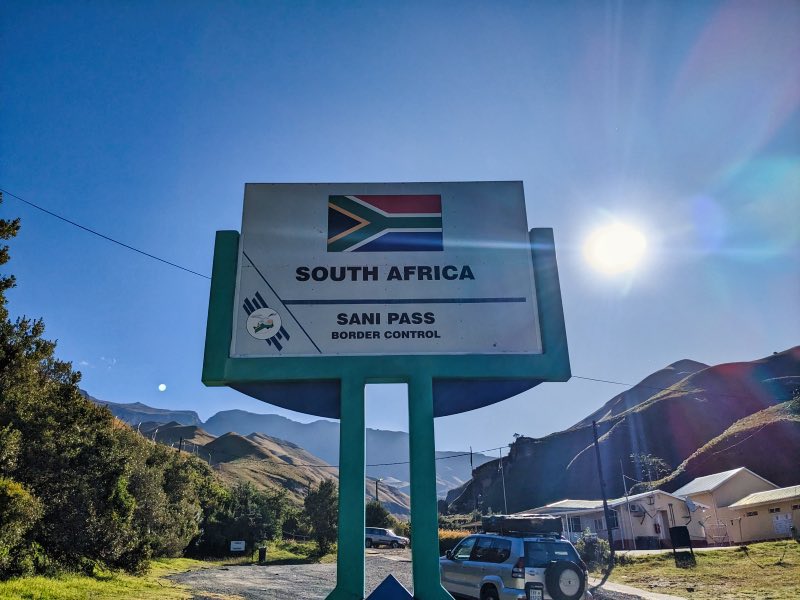
How difficult you find the Sani Pass will vary depending on your 4×4 driving experience, what kind of vehicle you’re driving, and the current weather and road conditions.
That said, while it’s steep and twisty, it’s not particularly technical. So long as you take your time, you’ll be fine. (Of course, this depends on the season).
We drove the Sani Pass at the start of April in our Toyota Prado with standard clearance and we found the drive very manageable. There are a couple of more challenging sections towards the end where the road gets steeper and the turns become narrower, but overall, it was a really fun and enjoyable drive. It was the first (of many) adventurous roads we took our car on and we’d do it again in a heartbeat!
While I do have a fair bit of 4×4 experience, I hadn’t driven many other mountain passes before this.
Take home point: if this is your first time tackling a 4×4 road, you will find it challenging, but doable. If you’ve done some 4×4 driving before, you’ll have a lot of fun.
How long does it take to drive the Sani Pass?
It can take anywhere from 1 – 2 hours to drive the 9 km road up the Sani Pass. This will vary slightly depending our your driving experience, road conditions and the amount of stops you decide to take.
What kind of vehicle do I need to drive the Sani Pass?

The best vehicle for driving the Sani Pass is a high-clearance 4×4. When we say high clearance 4×4, we mean a proper 4×4 such as a Toyota Prado, Nissan Patrol or Land Rover Discovery and NOT an all-wheel drive such as a Toyota Rav-4 or a Nissan X-Trail.
While it is possible to drive the Sani Pass using an all-wheel drive vehicle, we would only recommend this option for experienced 4×4 drivers. This is because an all-wheel drive vehicle is considerably less powerful than a genuine 4×4 and has less clearance, meaning a greater chance of running into issues and extra skill required.
However, it’s not necessary to have an additional lift on your 4×4 (extra clearance) beyond the standard clearance. We drove in our Toyota Prado with standard clearance and didn’t experience any scraping.
Read next: The Essential Guide to Ts’ehlanyane National Park
Tips for Driving the Sani Pass
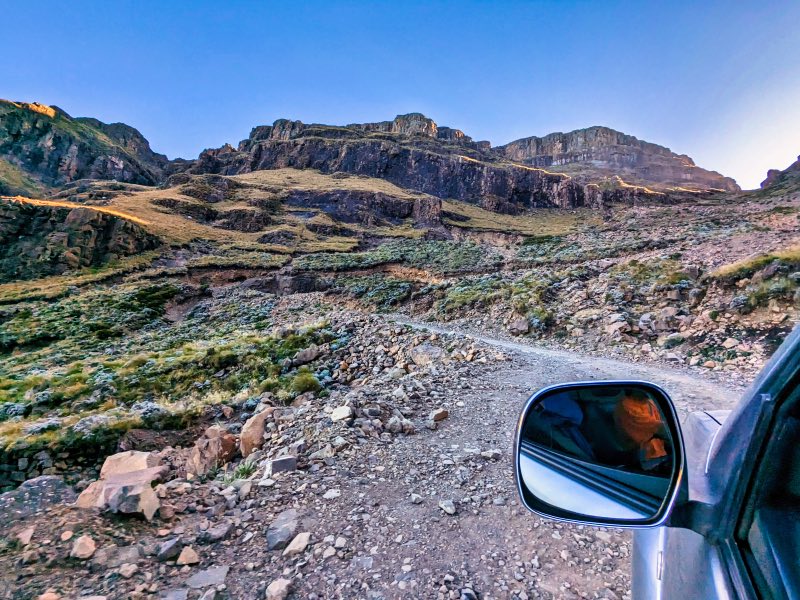
Drive slowly. The road is steep and winding, with many, many hairpin turns, so drive carefully.
Check the weather. Lesotho is a high-altitude mountain environment, so the weather can get crazy. Be prepared for sudden weather changes and check road conditions before starting the ascent.
Check your car. Ensure your vehicle is in good condition for the challenging journey with a good spare tire (and the ability to change a tire!)
Don’t drive in the late afternoon. The sun will be in your eyes as you ascend the Sani Pass, adding an extra unneeded challenge to the drive.
Stock up on supplies in Underberg. There are no fuel stations or shops at Sani Pass, so get what you need in South Africa before you head out (although fuel is slightly cheaper in Lesotho than in South Africa).
Travel insurance, as always, is essential. If something goes wrong, you want to be covered. We use and recommend SafetyWing. Trust us, we’ve used a lot of travel insurance and they really are the best.
Take your time and enjoy the ride!
Sani Pass Tours
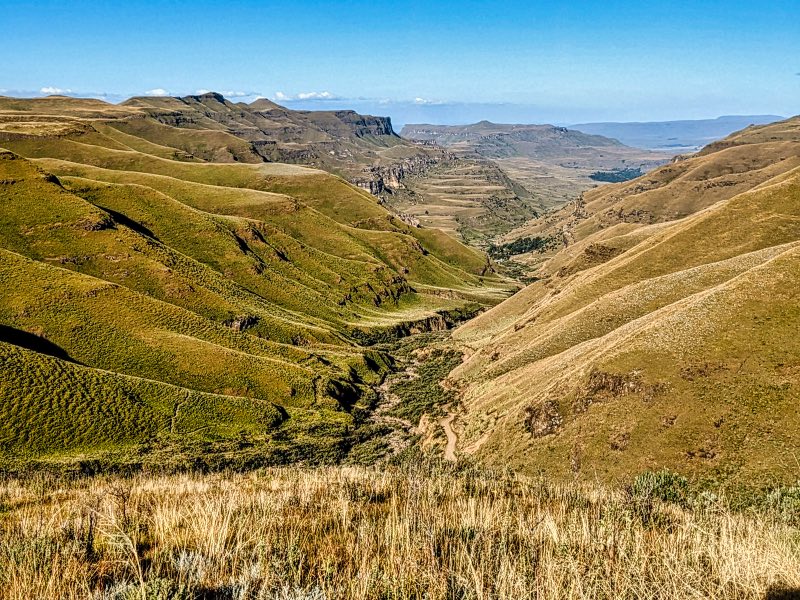
If you lack the confidence or car to drive the Sani Pass yourself or if you’d simply prefer to have an expert’s touch, there are a ton of excellent Sani Pass tour companies that will take you up there. Taking a Sani Pass tour is a very popular way to explore the epic pass.
When it comes to Sani Pass tours, there are 3 main options:
- Sani Pass day tours departing from the Drakensberg region of SA;
- Longer Sani Pass day tours departing from Durban, and
- Multi-day Sani Pass tours departing from Durban or the Drakensberg region.
All of these options include a 4×4 journey up and back down the Sani Pass and include stops at the Sani Mountain Lodge to visit the highest pub in Africa. Some Sani Pass tours also include a visit to a cultural village, meals and drinks.
Sani Pass Day Tours Departing from the Drakensberg Region of South Africa
These are generally the most popular Sani Pass tours as they provide an economical and timely way to experience the journey.
Longer Sani Pass Day Tours Departing from Durban
These are popular Sani Pass tour options for those who are based out of Durban and are looking for the easiest way to visit the Sani Pass.
Multi-Day Tours Departing from Durban or the Drakensberg Region
Want to really get out there and explore more of Lesotho? As you should, because there are so many amazing things to do in Lesotho!
These multi-day Sani Pass tours often offer flexible pick-up points and are a great option for those who are looking for more than just a visit to the Sani Pass, as they include additional activities such as hiking, pony trekking, visits to cultural villages and beyond.
Sani Pass Red Tape
The Sani Pass crosses from South Africa to Lesotho, therefore, there’s a bit of red tape involved, mainly passing immigration and paying a road tax.
Lesotho Immigration
Visitors from most countries do not require a visa to visit Lesotho. Just present your passport to immigration for your stamp, and you’re in!
Note that both the Lesotho and South African border posts are open from 6am to 6pm. You must clear both border posts by 6pm, so be sure to cross the South African border on the way up by no later than 4pm!
Lesotho Vehicle Road Tax
Self-driving visitors must pay a road tax for their vehicle, which is required to enter Lesotho.
The Lesotho road tax is 75 ZAR/LTL for a foreign-registered car (including SA-registered). The payment is made at the immigration post at the top of the pass. You can’t miss this as the road passes through the post and there is a boom gate blocking the way.
Sani Pass Accommodation
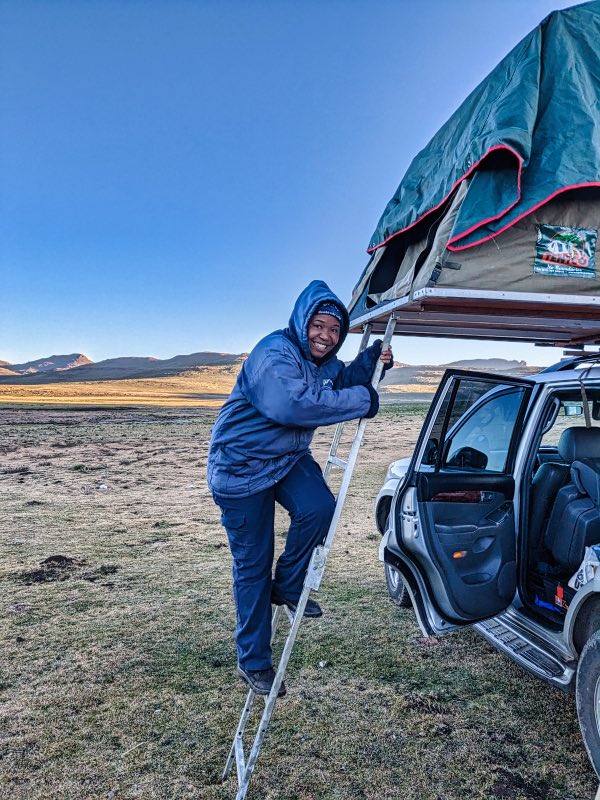
If you want to spend a night at the top of Sani Pass, there are a couple of options.
Masoba Soba
This is our preferred choice. Located just a few hundred metres past the Sani Mountain Lodge, Masoba Soba has super cute rondavels and the ladies who run it are super lovely (as evidenced by the photo above!).
If you’re overlanding and want to camp, they’ll let you camp on the grass for 100 LTL pp (what we did).
Sani Mountain Lodge
This is the longstanding option at Sani Pass. Expect basic rooms, but pretty high prices. The camping area is not great.
Where to Stay Near Sani Pass
If you’re looking for a place to stay near the Sani Pass, Underberg in South Africa has some great options.
What To Do Near Sani Pass
Have a Drink at the Sani Mountain Lodge Pub
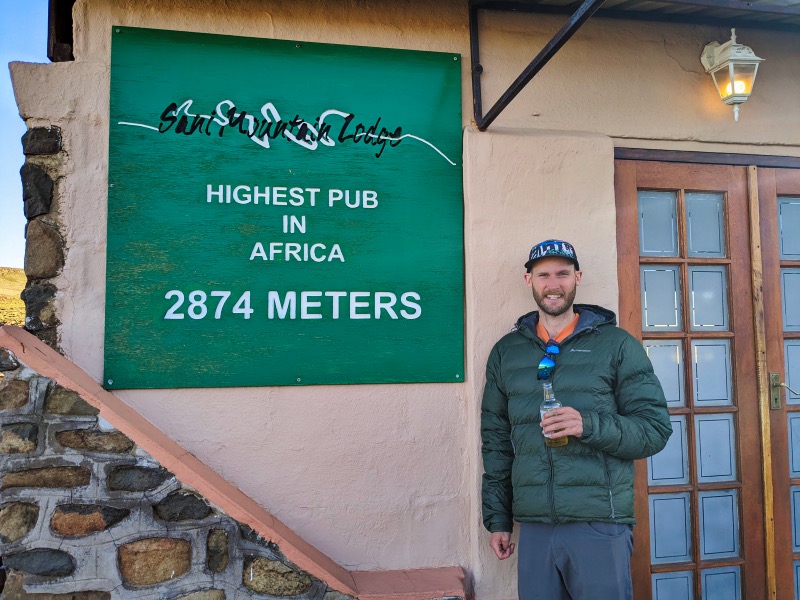
After your drive up the Sani Pass, we definitely recommend stopping for a drink at the Sani Mountain Lodge pub! It’s very cute and cozy.
While it claims to be the highest pub in Africa, that title actually belongs to the Simien Mountain Lodge in Ethiopia. But hey, does it really matter? The stunning panoramic views are awesome!
If you’re chilly up there and don’t want a cold beverage, fear not: they have hot chocolate!

Explore the Giant’s Cup Wilderness Reserve
En route to the Sani Pass is the Giant’s Cup Wilderness Reserve, undoubtedly one of the most beautiful parts of the Drakensberg Mountains.
In the reserve you can fish, camp, hike or simply just take in the views. If you can swing the time, we highly recommend spending a day or two in the Giant’s Cup area to experience this beautiful part of South Africa.
Day Hiking at Sani Pass
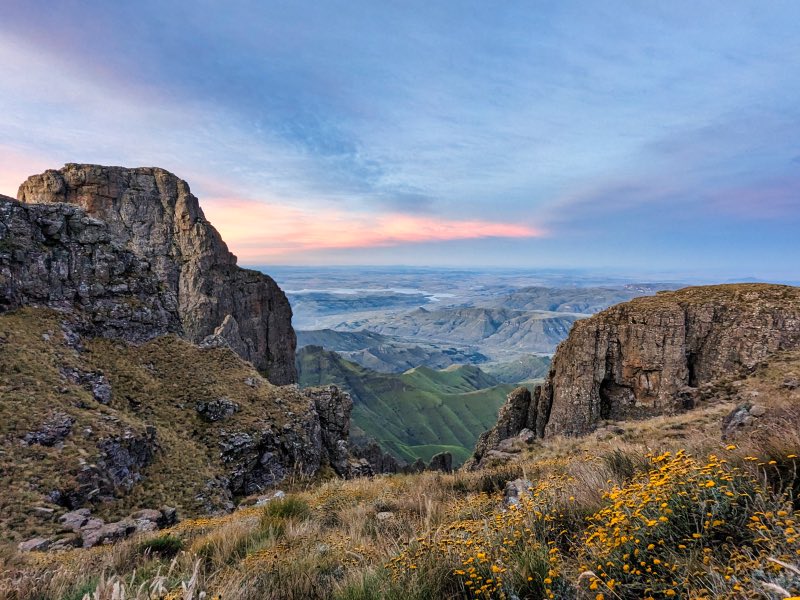
If you want to stretch your legs, there are also two excellent day hiking options starting near Sani Pass.
Hodgkin’s Peak
This 8.7-km circular trail departs near the border post and takes in some excellent mountain scenery. The moderately challenging route takes around 3 hours to complete.
The trail is well marked and it’s possible to complete without a guide. You can find a digital map here.
Thabana-Ntlenyana
At 3428m, Thabana-Ntlenyana is the highest Peak in Southern Africa. The 13km return trek departs from Sani Mountain Lodge and takes around 8- 9 hours to complete.
There’s a clear trail and you don’t need a guide but if you prefer, guides can be arranged from the Sani Mountain Lodge.
Disclaimer: This post contains affiliate links. This means that if you buy or book anything through them, we’ll earn a small commission at no extra cost to you. This helps us run this website and create comprehensive guides to help you get off the beaten track. We only recommend products and/or services that we use ourselves and trust.

